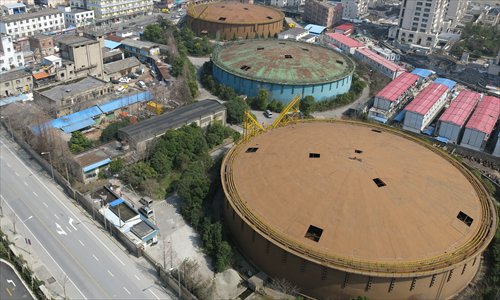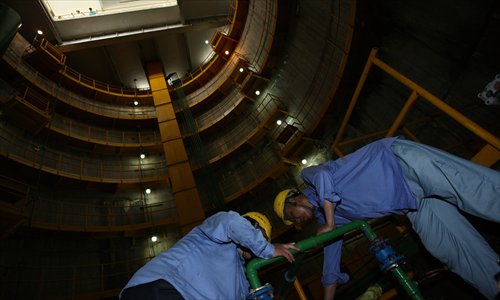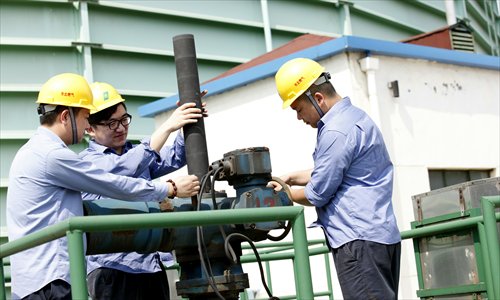Lighting the way
From a fishing village with a population of just 200,000 in 1843, Shanghai has developed into a huge modern city where more than 23 million people live. From the time Shanghai was forced to open up as a port in 1843, the city has witnessed remarkable change and progress. This year marks the 171st anniversary of Shanghai's opening-up and in this special series of reports, the Global Times will highlight some of the crucial moments, recall some choice memories of olden days and uncover some of the secrets of the city. Don't miss these exciting insights into the metropolis.

Abandoned gas holders on Jinshajiang Road in Putuo district Photo: Du Qiongfang/GT
Nearly half of Shanghai's gas holders will be removed by 2015. The coal gas (or town gas) that has been keeping the city's kitchens cooking since the 1970s is being replaced by natural gas, a more efficient and cleaner energy source. The work is being carried out as part of the 12th Five-Year Plan (2011-15).
The 50-meter-high cylindrical gas holders have been landmarks around the city for a long time. Known as meiqibao the first was constructed on Yu Ya Ching Road (now Xizang Road Middle) in 1865 by the Shanghai British Gas Co which had its offices and the residences for senior staff at 2524 Yangshupu Road in Yangpu district.
Originally Shanghai's gas supplies were used to provide light not heat. Major streets like Nanjing Road and the Bund were lit by gaslight and some of the wealthier foreigners had gaslights installed in their homes.
"The home of the secretary of the Shanghai British Gas Co was the first home lit by coal gas," explained 69-year-old Qin Xiong, who had worked for the North Shanghai Gas Business Co since 1998 although he has now retired. "From then on gaslights began replacing the kerosene lights that had helped light the streets before."
The plant supplied coal gas mainly to the homes of foreign businessmen's families and some of the wealthy Chinese families living in the concessions. "Most people in the city however had no idea of what coal gas was," amateur historian Qin said.
The plant produced some 50,000 cubic meters of coal gas every day. The gas holder stored 1,700 cubic meters of gas but supplied fewer than 100 households in the beginning.

Qin Xiong shows how to use an antique gaslight. Photo: Du Qiongfang/GT
Quite expensive
"The price of the gas was quite expensive at that time. For what it cost for one cubic meter you could then buy 2.5 kilograms of rice (though the gas was only used for lighting not cooking). Nowadays the same amount of gas would cost 1.25 yuan (21 cents) which would buy about 250 grams of rice. So the people who had gas installed were important figures or wealthy," Qin said.
Gas lighting was not at first welcomed by the citizens as a whole. Some people were worried about the gas and some were downright scared of it. Because the gas pipelines were buried underground, some of the rickshaw drivers believed that the pipes were boiling hot and directly above these pipes the roads would scald their feet so they constantly reminded each other not to go barefoot along some streets.
Other people believed the water in water pipes near gas pipes could be poisoned so they warned everyone not to drink the water.
"But most ordinary citizens were just curious. They called it zilaihuo (spontaneous flame). It burst into flame as soon as it was lit but because it was so expensive most ordinary folk had no experience with it," Qin said. The only Shanghainese who used gas were from wealthy families or young professionals who were working with Westerners.
But after electricity was introduced into Shanghai in 1882 gas lighting could not compete and electric lights gradually replaced the gaslights on the streets and in homes. "Electricity became popular quickly and later gas was adapted and began to be used for cooking and heating along with some industrial applications."
Industrial demand
By 1932 factories in the city industry needed more gas supplies and a British businessman built a new plant on Yangshupu Road near Longchang Road in Yangpu district. After the new plant, which could produce 110,000 cubic meters a day, was commissioned the old plant was shut down. "While the demand for gas was increasing it became apparent that unless the plant could produce a lot more gas the gas business would not thrive."
When the Japanese invaded Shanghai in 1938, they built a third gas plant, the Wusong Gas Plant, to meet the demands of the occupying forces.
"Between 1865 and the 1980s, there were only three gas plants operating in Shanghai and all had been built by foreigners. It was a humiliation for some that all these gas plants had been designed and built by foreigners. But the introduction of gas production technology helped spur Shanghai," Qin said.
In the 1960s and 1970s most households in the city used coal or coke stoves to boil water, cook and heat. The first thing for a longtang family to do in the morning (after emptying the chamber pot) was to light the coal stove. Often this involved lighting newspaper and small pieces of kindling wood and someone would have to fan these until the coal caught fire properly. It could take up to 20 minutes. Only after that could a family put water on to boil and begin the day properly.
In those days longtang all over the city were swathed in smoke from the coal fires and this was very obvious at dawn and dusk.
Coke was easier to use and a coke stove could be left burning all night so that it did not need to be lit again in the morning. (Coke was reportedly first used in China in the 4th century and by the 9th century was being used for cooking and heating).
"A lot of Shanghainese remember well the problems coal stoves created. If you were in a hurry to light the stove it would never light quickly. But they made people closer to each other. If your neighbor's stove was alight and burning you could put a piece of your coal in his stove, wait until it caught alight and take it home," Qin said.
After Shanghai was liberated in 1949, the government took over the Wusong Gas Plant and the Yangshupu Gas Plant and, in 1953, established the Shanghai Gas Company. However it was not until the late 1970s that coal gas began to be widely used in the city. Records showed that in the 1980s there were still 800,000 coal or coke stoves pushing smoke out into the city every day.
In 1983 the city government designed and built its first homemade gas plant, the Shanghai Pudong Gas Plant, which could produce 2 million cubic meters per day. In the 1990s, the Shanghai Shidongkou Gas Plant was built.

Gas company workers carrying out maintenance inside a gas holder Photo: Courtesy of North Shanghai Gas Business Co
The peak era
"The 1980s and 1990s were the peak era for coal gas in the city," Qin said. Whether a family could be connected depended on whether there were gas pipes laid and whether there was plant operating that could supply their home. "Everyone in a longtang got excited when they heard gas pipes would be laid to their lane."
Qin and his family lived on Huaihai Road in the late 1970s when they started to use coal gas. "We had to discuss with the neighbors where we would install the new stove in our shared kitchen," he recalled.
The Shanghai Gas Company raised money for this extensive citywide project by issuing bonds and charging installation fees. The bonds were redeemable with interest after five years.
And in those days when skyscrapers and high-rise apartments were rare the 22 gas holders scattered around the city were landmarks. Locals would stop alongside tourists to admire the gas holder on Xizang Road Middle.
Apart from the gas holder on Xizang Road Middle, there were four near Chezhan Road South and Wenshui Road East, six near Longwu Road and Chengjiang Road, four near Caobao Road and Hongcao Road South, four near Yanggao Road South and Chengshan Road and three on Jinshajiang Road.
Shanghainese took to using the gas holders as a guide to visitors and when giving their addresses out to friends would tell them to look out for "the gas holder at the back."
Young poets and writers compared the rise and fall of the tops of the gas holders to the rise and fall of life. These gas holders used a complex system of water pressure and a floating top to maintain pressurized gas supplies through the pipelines.
By the end of the 1990s, some 2.37 million households in Shanghai were using coal gas with the highest daily gas consumption recorded at more than 8 million cubic meters. Hardly any coal or coke stoves were in use by that time.

Gas company workers adjust pressure equipment at a facility. Photo: Courtesy of North Shanghai Gas Business Co
The successor
But then at the end of the last century coal gas met its successor when, in 1999, natural gas from the East China Sea arrived in Pudong. Natural gas is a superior product, a clean, environmentally friendly and efficient source of heat. It has minute quantities of pollutants and compared with coal gas reduces emissions of sulfur dioxide by nearly 100 percent, of carbon dioxide by 60 percent and nitrogen oxide by 50 percent. It has a calorific value of up to 2.6 times that of coal gas.
"Although the price of natural gas is a little higher the monthly cost of household gas is almost the same as before because the calorific value is higher," Qin said.
From 1999 coal gas has been gradually replaced throughout the city. In 1999 110 million cubic meters of natural gas were being produced and this soared to 1.07 billion cubic meters in 2004 and 2 billion cubic meters in 2006. Last year 6.81 billion cubic meters of natural gas were used in the city.
There are five natural gas sources supplying Shanghai - the East China Sea, the first and second West-East natural gas transmission projects, the Sichuan-East gas transmission project, and liquefied natural gas imported from Malaysia.
Natural gas does not need gas holders unlike coal gas which needed the holders to store, regulate and pressurize supplies, so the city's former landmarks are obsolete.
To date eight gas holders have been taken down - after 26 years of service - and three will also be farewelled shortly. The others will be kept in use for the present. About 330,000 city households were still using coal gas at the end of last year.
An inevitable move
Qin thinks the move to natural gas has been inevitable and should be seen as a historic milestone for the industry. "When coal gas arrived the coal and coke shops began shutting down. With natural gas it's logical that coal gas will fade into history as well. Coal gas production would have contributed to some extent to the pollution in Shanghai. The gas works became the place where coal was burned instead of in homes."
People are divided as to whether the gas holders should go or be retained. Some think they are part of the city's history and should be preserved as relics. Others believe the gas holders should be removed completely as they could be dangerous.
In some Western cities gas holders have been preserved in creative ways. In Vienna, Austria, some historic gas holders have been converted into residences.